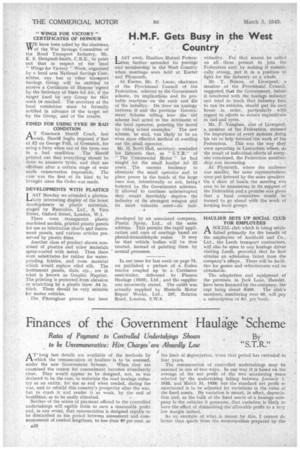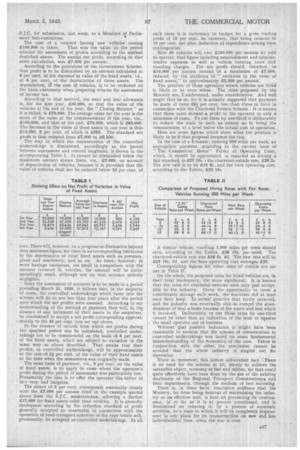Finances of the Government Haulage Scheme Rates of Payment to
Page 18

Page 19

If you've noticed an error in this article please click here to report it so we can fix it.
Controlled Undertakings Shown By to be Unreinunerative: Hire Charges' are Absurdly Low AT-long last details are available of the methods by which the remuneration of hauliers is to be assessed,
under the new Government Scheme. When they are examined the reason for concealment becomes abundantly clear. They would appear to be designed, not, as was declared to be the case, to maintain the road haulage industry as an entity, for use as and when needed, during the war, and to rebuild this country's prosperity after the war, but to crush it and render it so weak, by the end of hostilities, as to be easily absorbed. Neither of the scales of payment offered to the controlled undertakings will enable them to earn a reasonable profit and, in any event, that remuneration is designed rapidly-to be diminished as the period between assessment and commencement of control lengthens, to less than 40 per cent. as the limit of depreciation, when that period has extended to four years.
The remuneration of controlled undertakings may be assessed in one of two ways. In one way it is based on the
average of the net profit of the two accounting years selected by the undertaking falling between January. 1," 1935, and March 31, 1939; but the standard net profit so " ascertained is to be adjusted for variations in the value of the fixed assets. By variation is meant, in effect, depreciation and, as the bulk of the fixed assets of a haulage company is-'the vehicles it possesses, that variation is likely, to have the effect of diminishing the' allowable profit to a very
low margin indeeiL . .
As an example of what is meant by this, I cannot do better than quote from the niernorandiun prepared by the S.J.C. for submission, last week, to a Members of Parliament Sub-committee.
The case of a concern having new vehicles costing £100,000 is taken. That was the value at the period • selected for assessment of profits according to the method described above. The annual net profit, according to that same calculation, was £7,090 per annum.
According to the provisions of the Government Scheme, that profit is to be diminished by an amount calculated at 6 per cent. of the decrease in value of the fixed assets, i.e., at 6 per cent, of the depreciation of those assets. The depreciation, i the case of vehicles, is to be reckoned on the basis customary when preparing returns for assessment of income tax.
According to that method, the wear and tear allowance is, .for the first year, £30,000, so that the value of the vehicles at the end of the year, the " Closing Balance " as it is called, is £70,000. The.average value for the year is the mean of the value at the commencement cif the year, viz., £100,000, and that at the end, £70,000, which is £85,000. The decrease in .the value of these assets in one year is thus £15,000, 6 per cent, of which is £900. The standard net profit is thus reduced from £7,000 to £6,100.
The way in which the remuneration of the controlled undertakings is diminished, accordingly as the period between assessment and control lengthens, is shown in the accompanying Table I. It cannot be diminished below the maximum amount shown there, viz., £2,669, on account of depreciation of vehicles, because it is provided that the value of vehicles.shall not be reduced below 25 per cent. of cost.. There will, however, be a progressive diminution beyond that minimum figure, for there is no corresponding limitation to the depreciation of other fixed assets such as. premises, plant and machinery, and so on. As these, however, in most haulage businesses, are Small in comparison with the amount invested in vehicles, the amount will be correspondingly small, although not on that account entirely negligible. Since the assessment of accounts is to be made in a period preceding March 31, 1939, it follows that, in the majority of cases, the controlled undertakings which came into the scheme will do so not less than four years after the period over which the net profits were assessed. According to my understanding of the method of payment they will, in thv absence of any increment of their assets in the meantime, be condemned to accept a net profit corresponding approximately to the 40 per cent, rate set out above.
In the absence of records from which net profits during the specified period can be calculated, controlled undertakings are to be remunerated on the basis of 6 per cent. of the fixed assets, which are subject to variation in the same way as above described. That means that their profits, as controlled undertakings, will be approximately at the rate of 24 per cent, of the value of their fixed assets .at the time when the assessment, was originally made.
• The same basis of payment, viz., 6 per cent, on the value of fixed assets, is to apply in cases where the operator's profit during the period of assessment was particularly low. Presumably the idea is to offer the operator the better of two very bad bargains.
The return of 6 per cent, corresponds reasonably closely with the £7,000 per annum cited in the example quoted above from the S.J.C. memorandum, allowing a further £17,000 for fixed assets other than vehicles. It is absurdly inadequate according to the orthodox standard of profit generally accepted as reasonable in connection with the operation of road-transport concerns of the type which will, presumably, be accepted as controlled undertakings. In all. such cases it is customary to budget for a gross trading profit of 15 per cent, on turnover, that being reduced tb 10 per cent, net after deduction of expenditure arising from contingencies.
Now 50 vehicles will cost £100,000 per annum all told to operate, that figure including establishment and administrative expenses as well as vehicle running costs and standing charges. The net profit should, therefore, be £10,000 per ,annum instead -of a maximum. of £7,000, reduced, by the incidence of " variation in the value of fixed assets," to approximately £2,500 per annum.
The position of those operators where vehicles are hired is likely to be even worse. The rates proposed by thg Ministry are, I understand, under consideration. And well might that be so, for it is actually suggested that payment be made at rates Sal per cent, less than those in force in connection with the Chartered Vehicle Scheme.. It is known that those rates showed a profit to the operator in only a minimum of cases. To cut them by one-third is deliberately to reduce the scale to such an extent as to bring the remuneration to a level below the actual cost of operation.
Here are some figures which show what the position is likely to be if that proposal becomes the rule.
In the case of a 5-tonner, running 600 miles per week, an appropriate payment, acc,prding to the current issue of "The Commercial Motor" Tables of Operating Costs, which, it should be appreciated, is regarded as setting a fair standard, is £27 10s. : the chartered-vehicle rate, £29 2s. The new rate is to be £19 8s. and the bare operating cost, according to the Tables, £20 155.
A similar vehicle, covering 1,000 miles per week should earn, according to the Tables, £38 105. per. week. The chartered-vehicle rate was £38 5s. 4d. The new rate will be £25 10s. Sid. and the bare operating cost averages £30.
Corresponding figures for other sizes of vehicle are set out in Table II.
On the whole, the proposed rates for hired vehicles are, in 'their total inadequacy, ttie more significant. It is known that the rates for chartered vehicles were only justacceptable to the industry. Given the opportunity to cover a considerable mileage each week, the machines did at least earn their keep. In actual practice that rarely occurred, and the industry was eventually able .to compel the abandonment of that scheme because of the waste and loss which it involved. Deliberately to cut those rates by one-third cannot be other than an indication of the wish to squeeze the small operator out of business.
Without that positive indication it might have been reasonable to surmise that the scheme of remuneration to controlled undertakings was based on some fundamental misunderstanding of the economics of the case. Takers in conjunction with the other, the conclusion cannot be avoided that the whole industry is singled out for repression. There is, moreover, this almost self-evident fact. 'There is no need for the scheme at all; merely to achieve the ostensible object, economy of 'fuel and rubber, for that could quite effectively have been done by the use of the existing machinery of the Regional Transport Commissioners and their departments, through the medium of fuel rationing.
There is, in these facts, conclusive evidence that the Ministry, far from being desirous of maintaining the industry as am effective unit, is bent on preventing its continuance, inso far as it is at present constituted, and is determined on reducing it, by a process of economic attrition, to a state in which it will be completelY acquiescent in any plans for its reconstruction on new and. -less
individualistic lines, when the war is over. •




















































